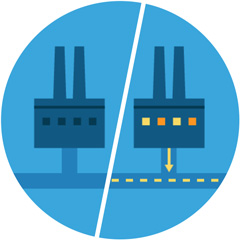Electricity is measured in both capacity and energy—watts and watt-hours. Understanding the difference is critical to understanding how the power grid works.
Capacity is the maximum output an electricity generator can physically produce, measured in megawatts (MW). You’ll often see the ISO refer to nameplate generator capacity, which is the manufacturer’s determination of the maximum megawatt output of electricity a generator can produce without exceeding design limits. Demand Resources are measured by their capacity to reduce demand, also in MW.
The capacity of these resources together forms the capacity for the power system. ISO New England is required by federal reliability standards to ensure the region has enough resources to meet a minimum total system capacity level (the Installed Capacity Requirement). ISO New England uses a competitive Forward Capacity Auction to secure resources to meet projected system capacity needs three years in advance (called a capacity supply obligation). New England’s power grid has different capacity levels in summer and winter as differing temperatures can affect how much output a generator is capable of producing. The ISO posts how much capacity is available each day to meet projected peak demand in its Morning Report.
Energy is the amount of electricity a generator produces over a specific period of time. Many generators do not operate at their full capacity all the time. For instance, about 26% of New England’s system capacity is made up of coal- and oil-fired generators. But combined, they produced just 3% of the region’s electric energy in 2017. A generator's output may vary according to conditions at the power plant, the availability and cost of fuel, variability of wind and sun, market prices, or dispatch instructions from the ISO. That’s why it’s important for the system to have a variety of resource types, including those that can start up or dial back quickly in response to sudden changes in consumer demand or the output of other resources.
Consider this recent real-world example of the difference between capacity and energy, from winter 2017/2018:
